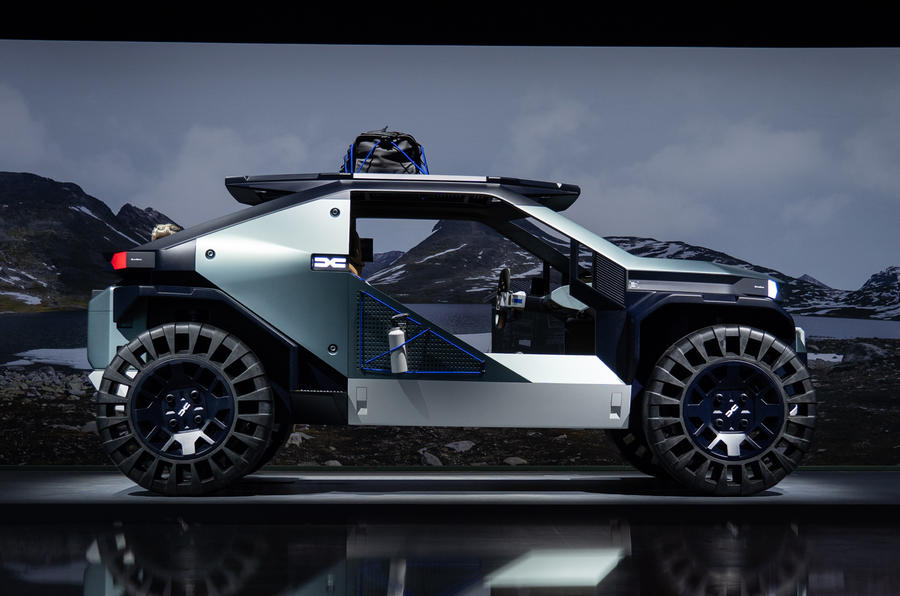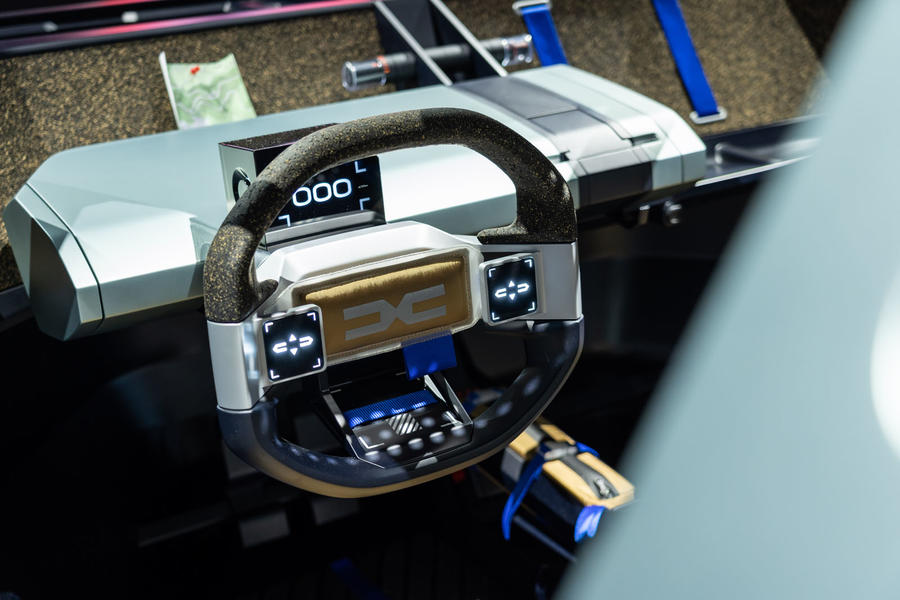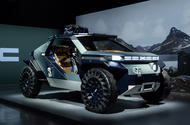Manifesto is partly a response to Dacia’s growing appeal with those who enjoy outdoors pursuits
New concept car does not preview any future model but showcases future technologies and ideas
Dacia has previewed a whole series of new features it hopes to offer on its future models on a bold new concept car that’s set to star at next month’s Paris motor show.
The Dacia Manifesto concept is a rugged off-road buggy, similar in size and style to the Ariel Nomad. While the two-seater is not a direct preview for any future model, it is a statement of intent of how the brand sees itself evolving, as well as a technological showcase for the brand in what it calls a “lab for ideas” – hence the Manifesto name.
Dacia design director David Durand said the new concept was a “super compact open air vehicle blended in with nature. It’s a great way to brainstorm ideas without the pressure of production”.
The new concept car coincides with a new brand mission for Dacia to switch from being “simple and affordable to more appealing and desirable, with cars chosen as people want them”, according to CEO Denis Le Vot, “but still chosen for being essential”.
Dacia’s advanced design chief Romain Gauvin told Autocar that work on the concept only began in January. The Manifesto is also a response to Dacia’s growing appeal among those who enjoy outdoor pursuits and active lifestyles.
It has no windows, doors or even a windscreen, and Dacia claims it is excellent to drive off-road thanks to four-wheel drive, large wheels and tyres, a raised ride height and “a body built to withstand the toughest terrain”.

Airless tyres are one feature on the Manifesto that Dacia is actively known to be working on for production. The 850mm tyres are puncture proof and designed to last the life of the vehicle.
The car is completely waterproof, allowing the interior to be hosed out when it gets dirty. The seat coverings are also removable, and once removed they can be used as sleeping bags.
The concept car incorporates Dacia’s ‘Bring-Your-Own-Device’ approach to infotainment, where the computing power and technology is provided by a user’s smartphone.
The Manifesto introduces Dacia’s ‘YouClip’, a feature that will be offered in its future models starting with next year’s next-generation Duster. It is essentially a universal mounting point, which can house a whole host of accessories from cup holders to phone mounts. In time, it could even replace cup holders altogether, according to Gauvin.
The concept car is of no specified drive type, with Gauvin describing it as ‘multifuel’, able to be powered by anything from petrol and LPG to hybrid and electric. It is extremely lightweight, with a claimed weight of 720kg when fitted with the heaviest of its potential drivetrains, an all-electric one.
Dacia says that the Manifesto is constructed from lightweight, sustainable materials, among them parts of the chassis and bodywork. This is made from a new type of plastic called Starkle, which features 20% recycled and already processed polypropylene to give the panels a flecked look. It will also be used on future models starting with the Duster for exterior cladding.

This lightweight approach is absolutely key for Dacia in order to keep its pricing down, and is a strategy the firm will continue to employ in the future. The lighter its cars, the less emissions they produce, and the lower the cost can be due to them only having what equipment is needed.
“This is not just a PR exercise,” said Dacia sales and marketing boss Xavier Martinet. “This is about what it means to be light. The Jogger weighs 300kg less than its rivals. With a lighter car that still carries the same purpose [to carry seven people in the case of the Jogger], you don’t need a bigger engine, or to electrify it. It has the same purpose with only 119g/km CO2 emissions for half the price of the competition, and this [Manifesto] is another example of how Dacia cars can make a difference.”
Other innovative, sustainable materials include the use of cork and rubber for the dashboard to allow things to be pinned to it. There is no chrome or leather.
There is a removable battery pack mounted at the rear that can be detached and used to power whatever requires it. Just one headlight features, and it too can be detached from the car and used as a torch.
“Beyond our models, we are also working on innovative features that match our customers’ needs and lifestyles even more closely,” said Lionel Jaillet, Dacia product performance director. “Manifesto concept is a “lab” to try out and mock up new ideas. The version you can see today will keep on evolving as we keep on exploring.”
Building on its growing interest and appeal to outdoor lifestyles and pursuits, Dacia has also revealed a new folding bed option for the Jogger that will be available in 2023. This fits into a removable storage box in the boot, and folds out over the back seats as a mattress to allow two people to sleep in the back of the car. This is also expected to be offered on the Bigster when it launches in 2025.
Source: Autocar
